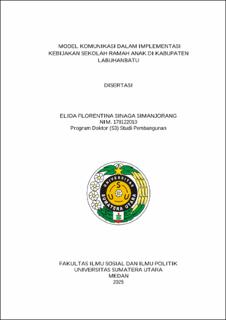Model Komunikasi dalam Implementasi Kebijakan Sekolah Ramah Anak di Kabupaten Labuhanbatu
Communication Model in the Implementation Of Child-Friendly School Policies in Labuhanbatu Regency

Date
2025Author
Simanjorang, Elida Florentina Sinaga
Advisor(s)
Lubis, Lusiana Andriani
Metadata
Show full item recordAbstract
This study aims to analyze the implementation of the Child-Friendly School (CFS) policy in Labuhanbatu Regency, with the goal of creating a safe, comfortable, and inclusive educational environment that aligns with the principles of the UN Convention on the Rights of the Child and the Ministry of Women's Empowerment and Child Protection Regulation No. 8 of 2014. Theoretically, this study is based on three main pillars: the concept of Child-Friendly Schools, which emphasizes child participation and protection; policy implementation theory, which identifies supporting and hindering factors; and a communication model that critiques conventional linear approaches and proposes a participatory model. The research methodology employs a descriptive qualitative approach with data collection techniques including field observations, structured interviews with various stakeholders (school principals, teachers, education offices, DP3A, Labuhanbatu Ministry of Religious Affairs, and child advocates), and Focus Group Discussions (FGDs), with the unit of analysis being three public elementary schools designated as SRA implementer schools. The research findings reveal that the implementation of SRA has not been optimal, with varying levels of achievement across schools. The main obstacles include an incomplete understanding of the policy, limitations in human and financial resources, and the absence of a precise evaluation mechanism. Additionally, the communication model currently in use remains one-way, flowing from the Education Office to schools without actively involving students and relevant stakeholders. Based on these findings, the study recommends the application of the ESIKA Communication Model. This holistic approach combines four key aspects (effectiveness, systematic, inclusive, and collaborative) while placing children as active subjects in policy implementation. This model emphasizes the importance of multi-stakeholder collaboration among seven stakeholders through effective and systematic two-way communication mechanisms.
